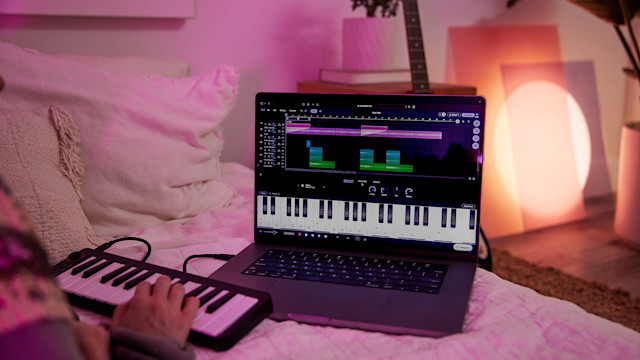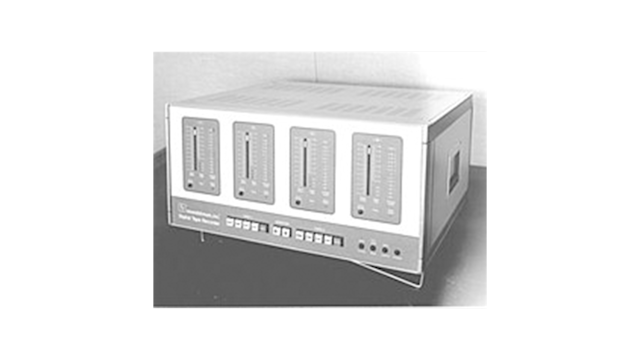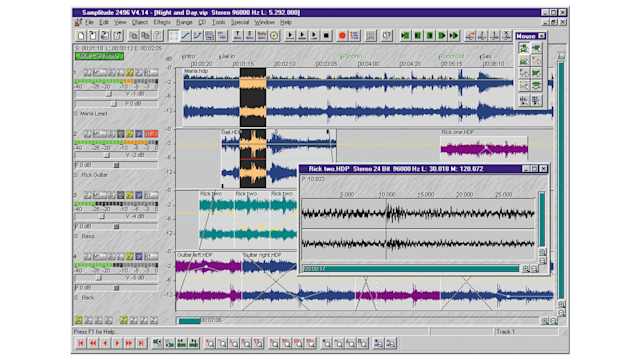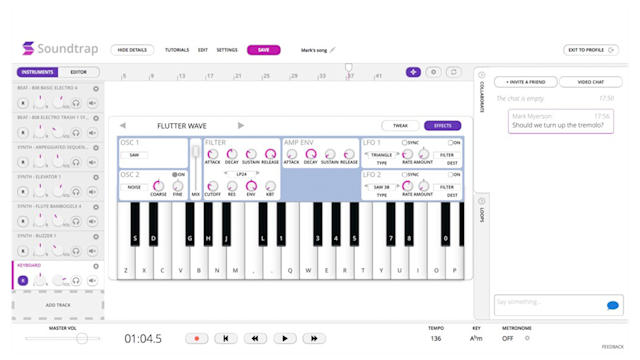The History of the DAW - How Music Production Went Digital
May 23, 2024 - From tape decks to laptops, explore the fascinating journey of music production! Discover how DAWs revolutionized music recording & creation.

The digital audio workstation- or DAW- allows musicians to record their work inside a highly editable program. But many musicians don’t know about the history of this staple of the music industry. Even if you’re a professional musician, you might not know much about the timeline of the first DAW to the creation of online studios/workstations like Soundtrap.
In this article, we’ll look at the broad strokes of the history of the DAW (digital audio workstation) From the first iterations of the DAW all the way up to the mobile DAWs and cloud-based production software of today…let’s dive in!
What is DAW Software?
DAW is a broad term for music software that allows for recording, editing, mixing, and more. Originally, the DAW had to have specific elements in order to be considered a DAW; you need an interface, computer, piece of software (for editing), and at least one input.

The first digital audio tape recorders: Soundstream
The First “DAW”: Soundstream
The first recorded official DAW was called Soundstream and was released in 1977 by Digidesign. Soundstream was primarily used to record classical music and a bit of jazz. Digidesign is now a part of Avid, the same makers of Sibelius and Pro Tools
Who Invented the DAW?
The company Soundstream was founded by scientist Thomas G. Stockham Jr. in 1975. Stockham is often called “The father of digital recording” because of the advances he made in digital sound technology.
Stockham was originally inspired to make changes to recording as he knew it when he realized that unwanted background noises and sonic distortions were high, and brass recordings sounded low quality. (Barber)
Soundstream started out small; they started out by selling only a handful (just 18!) of their devices in the mid-70s. These were the first digital recorders- ever. The first DAW was monumental because of its transformer-free technology. Soundstream DAW was invented before the CD and had a disk drive, viewable waveform, mini computer/DAP, and video display.
Who Invented Multitracking?
The evolution of multitracking is usually credited to Les Paul. Surprisingly, Les Paul began his work on multi-tracking in 1945. Then the first multi-track recorders were then made using his technology, by Ampex.
To quote Les-paul.com… “Les Paul began the modern era of audio recording” but Stockham is the one who drove it home into digital times.
In this article, we’ll discuss many DAWs but we wouldn’t have been able to do any of it if it weren’t for Les Paul and his original 8-track tape recorder, or Stockham and the first DAW.
“It was 1953, while filming the TV show when I got the idea for the first multi-track recorder, the eight-track. Working with film audio inspired me to want to build an eight-track recording machine where the heads were all evenly aligned, what we call sel-sync.
My invention was to stack the heads one on top of the other so they were all aligned in the same place, and you could use the same multiple heads for recording and playback, and everything would be in sync.
It didn’t really become functional until 1957 when we finally re-designed it ourselves to get it right. I worked on it for four years and it cost me about $36,000 total before I ever recorded the first song on it.” - Les Paul (Les-paul.com)
The Eras of Audio
First, there was the Phonautograph
Then there was the Phonograph and Gramophone
Next, we had analog tapes (think: large reels)
Then we made magnetic tapes smaller (think: cassettes)
Next, vinyls (analog copies of sounds/ pressed soundwaves)
And finally, we make it to the digital age (tapes, CDs, etc)
Before we get too far into digital technology, let's go over a sweeping history of recorded music. In recording history, we went from acoustic to electric, electric to magnetic, and magnetic to digital.
The first piece of recorded music was in 1857 when a phonautograph recorded a piece of a French folk song. You can listen to it below (although, fair warning, the quality leaves much to be desired. Next came the phonograph. Most all mechanical devices resulted in low-fidelity audio. The only things that sounded decent on them were horns. One of the next big inventions was the amplifier.
This is the first sound ever recorded. Captured by Leon Scott in April 9th, 1860, in his own voice.
In the 1930’s, the carbon microphone (suspended ring-type) microphones were common. This is around when the vinyl record first came out too. Next was the ribbon mic. Eventually, fidelity got better, the sound was added to films - and from there, the technology spiraled…
Next up was magnetic tape recording, which was created in Germany. This could be used to preserve both photos and audio and eventually led to the cassette tape. Audio tape technology ruled the market for decades. For example, the Ampex 350 tape recorder was used by Phil Spector to get his ‘wall-of-sound” type recordings. Think: The Ronettes, “Be My Baby”. Nearly everything Spector did was on 3-track audio. The instrumentalist played all at once, meaning that rehearsals were often brutally long and redundant.
In the digital era, it’s worth noting that the digital audio tape had a brief stint before the invention of the CD. And from there on out- well, you probably know the rest.
DAWs: The Perks of Moving Analog to Digital
Now that you know where we came from, it’s easy to see how good we modern musicians have it. Being in the digital age with access to DAWs has a lot of perks. Going digital meant….
No more losing tracks
Having simpler, faster editing
No more having to record the full length of a track (over and over)
New ability to add sonic dimension to recordings
Space for bigger longer tracks with more layers
Non-destructive recording and editing allowed musicians to record tracks over and over again without losing anything. Back in the day, there was no undo button, not on analog!
By the time we got the 4-track recorder, we were able to recreate the feeling of being surrounded by music - called quadrophonic sound. And by the second half of the nineties, we were able to use 32 separate tracks.
Most consider the digital era to begin after the mid-seventies - So, 1975 to present times. But in the past 50 years, we’ve had to work out quite a few kinks…
Issues Along the Way
Slow disk speed
Expensive storage
DAWs were limited to certain systems
If you’ve ever made a big multi-tracking project with a DAW on a computer that is a bit old, you know how frustrating the technology can be. But just imagine how many kinks had to be worked out before we got to this point here in 2024.
The slow disk speed and or processing was a big hurdle to overcome. As computers got better, so did DAWs. Apple, Commodore, and Atari were 3 main contributors. In the 90’s almost all DAWs were on Apple devices, which many households couldn’t afford.

The Samplitude Studio DAW around 1996
Samplitude: A Significant Windows DAWs
Samplitude Studio was originally an audio editor, and it first came out in 1992 for the Amiga and then later, for Windows in 1995. It came in 3 versions- One with 4 tracks, one with 8 tracks, and one with 16 tracks. Windows/Linux DAWs were late to the game, but they caught up eventually.
Increase in Track Sizes
The original DAWs were simple two-track editors. But as we worked our way into the early 90’s 2 track editors became 4 and 8-track editors. By 1996, 32-track recorders were widely available. In some ways, we went backward to go forward again, as the first 32-track digital tape came out in 1979.
DAW Innovations of the 80s and 90s
Sound Designer and Sound Tools -1985
Cakewalk Sonar -1987
Cubase Audio MAC - early 90’s
NotatorLogic - 1993
Like many DAWS of the 80’s Cakewalk was originally a MIDI sequencer which eventually became a workstation. The first DAW I Personally ever used was Sonar/Cakewalk. I was just a kid when I asked for it. While many people made a lot of music on Cakewalk, I was too young to understand the program, and mostly just noodled around and tried to create mashups of songs in different keys. Cakewalk is now owned by Bandlab, which is known for its mobile DAW.
In 1985, Sound Designer, the first precursor to Protools, first came out. Then the first Cubase iteration came out in 1989 for an Atari ST. In the early 1990s, Cubase Audio for MAC was released. The release of the Cubase Audio MAC program was revolutionary because musicians now had the ability to see a score alongside editable MIDI and audio files.
Logic was originally called NotatorLogic and was made by a German company called Emagic in 1993. At this point, it was mostly used to sequence music and write scores - so it wasn’t technically a digital audio workstation yet. However, it was popular/ well-known and available on 3 systems: MAC, Windows, and Atari. Impressively it had the ability to quantize, transpose, and other features that were pretty powerful for the time. NotatorLogic’s setup and the original program served as inspiration for DAWs to come.
Popular DAWS Today (and their initial release dates)
Many of the DAWS we have today are still owned by the original companies and makers. Cubase, Protools, and Logic and Cubase all have roots in much earlier pieces of software, as you can see above.
Cubase (Steinberg) (1989)
ProTools (1991)
Logic (1993)
Reason (2000)
Ableton (1999, 2001)
I have personally used all but one of the above digital audio workstations (Ableton). When I was taking recording classes at the university level (from 2014-2018) I was told that ProTools was the industry standard.
However, I’m not sure that that’s entirely accurate, as many professional producers use Logic. And with the introduction of accessible, economical online DAWs, like Soundtrap, it seems that the music industry is changing more and more by the day.
Prices of DAWs today have come down significantly - For example, when Protools was first released in 1991 and cost $6,000 for just 4 tracks. Today, you can get access to a Soundtrap Premium subscription for around $100/year, and of course unlimited tracks are included ;)
Invention of Virtual Studio Technology
DAWs allowed for the looping and cutting of sounds, which was huge for the time…But then Cubase was the first to release VST - virtual studio technology- in 1996. VSTs are plugins that place effects and synthesizers inside DAWs. So, VSTS can be digital instruments or effects.
Having delay, a compressor, or digital instruments inside DAWs was revolutionary back when they first came out. Nowadays, we are very fortunate to have there are loads of VSTs/plugins at our disposal.
Advances in 21st-Century DAWS
Improved film/video game music production software
Mobile Audio Workstations
The invention of the first cloud-based DAW
Sampling technology and VSTS improved, resulting in better DAWs for producing film and video game music. For example, the Nuendo was developed and released by Steinberg in 2000 and an interaction of the program is still being used to make music video games/virtual reality. Inside it, you can arrange, edit, and perform post-production. It is also one of the most popular DAWS used to create music for film - and is even Netflix and Dolby certified.
The next big leap in 21st-century workstation tech was mobile audio workstations- That is DAWS on phones. Think apps along the lines of Garageband for iPod touch (2011), Caustic (est 2013), etc. Technology got to the point where we could loop, cut, and apply VTS- all on our mobile devices. But then DAWs made another advancement, resulting in a full online studio.

Soundtrap: The first release of an online DAW in 2013
Soundtrap: The First Cloud-Based DAW
Sountrap was first released in 2013 and is the first cloud-based DAW. It can operate on any system- Linux, MAC, chrome, Linus, IOS. Online digital audio workstations such as SoundTrap have a multitude of features from vocal editing to EQings, effects, and more.
Soundtrap is the first online browser-based digital audio workstation. Being able to make music in the cloud has a number of advantages, including faster and easier collaboration. From synths of the pattern beatmaker to vocal cleanup and effects, there’s a myriad of creative opportunities. Features such as panning can now be done entirely on your browser.
Cloud-based DAWs are the part of the future of DAWs. Long gone are the days of expensive disk space and trouble with RAM, or software that is exclusive to certain brands of computers. Now, everything can now be done online in our browser.
How Music Production Went Digital: A Timeline
1857 The first recording of music was created
The 1910s The first amplifier
The 1920s-30s Reel-to-reel magnetic tapes
1930’s-40s Vinyl tapes released
1945 Les Paul/ invents multitracking
Late 1940’s First Ampex tape recorder released
1977 The first DAW, Soundstream, was released
1984 Steinberg first formed
1985 Precursor to Protools is released
1989 Cubase 1.0
1993 NotatorLogic, precursor to Logic, is released
1995 The first DAW for Windows is released
1996 The first VST is created by Steinburg
1999 Ableton comes our
2000 Reason is released
2000 Nuendo is released
2013 Soundtrap, the first online cloud-based DAW is created
Integration of AI into DAWs
In the past 10 years, AI has crashed the digital music production party, and it's bringing serious tools! DAWs are getting smarter, with AI assistants ready to be your musical wingman. Stuck on a melody? No sweat, AI plugins and software in your DAW can spitball some cool ideas that fit your vibe. Need to clean up a noisy recording? Bam, AI de-noisers, like Soundtrap’s Vocal Cleanup can get the job done in seconds.
This is just the beginning, though. Imagine AI that can analyze your favorite tracks and generate new sounds in that style, or even co-write a killer hook with you. The future of music making is all about humans and AI jamming together, making music creation more accessible and streamlined.
Regardless of how you feel about this evolution, it’s going to be an interesting ride and I, for one, am very excited about what the future might hold.
History of the DAW: Conclusion
It’s crazy to think that it only took about 50 years for music technology to escalate to what it is today. From Soundstream of the 1970s to the first cloud-based digital audio workstation, and AI assistant tools today.
Thanks for sticking around until the end of the history of DAWs. Be sure to check out Soundtrap- our online, cloud-based DAW-so that you can get started making music for free today.
About the author
Aleah Fitzwater is a multi-instrumentalist, songwriter, music journalist, and blogger from Temperance, United States. Aleah holds a Pk-12 instrumental music education degree. Her main instruments are flute, piano, drums, bass, and guitar.
Get started with Soundtrap today!